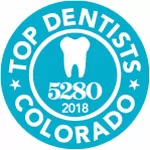It’s time to think differently about childhood tooth decay in Lone Tree. Unless you’ve been keeping up with the research (and who does?) you might have an incomplete understanding.
Here are three essential things to know about children’s dental health.
1. Tooth Decay Is The Most Common Childhood Disease
Over 4 million preschoolers have decay. Another unfortunate fact; tooth decay in young children is on the increase.
Why? There are several factors. Many young diets contain more sugar. Fewer children drink water that has been adjusted for fluoride levels. Many families don’t have dental insurance to help pay for care.
2. Tooth Decay Bacteria Can Spread
In a way, tooth decay is contagious. Huh? Let’s explain. Bacteria that cause decay is in the mutans streptococcus family. The bacteria mix with sugar. This mixture creates a powerful acid. The acid reduces the calcium in tooth enamel. When the bacteria persists on teeth, it produces a yellowish substance called plaque. Plaque is brutally effective at drilling into tooth enamel.
Mothers, fathers, siblings, and caregivers can transmit the bacteria to babies. Of course, young children can get tooth decay if they don’t have this bacteria. But the presence of it increases the risk.
Some kids are better at resisting this bacteria. How do you know if your child has an increased risk? If parents have a lot of tooth decay, the child is more susceptible to it. The child’s diet and daily oral hygiene also affect the risk.
The American Academy of Pediatrics (AAP) recommends pediatricians to ask parents about their dental health. Parents whose children are at a higher risk for decay should speak with a pediatric dentist. They can help your youngster beat the odds and emerge from childhood without a mouthful of fillings.
3. Weakened Enamel Can Repair Itself (Up To A Point)
If the teeth are continuously assaulted with juice, milk, and snacks, the enamel never has a chance to remineralize. The juice, milk, and snacks create dangerous acid. Acid and plaque decreases the enamel and may cause a white spot. This is a sign of mineral loss. It’s the first step in the formation of a cavity. At this point, you can reverse the mineral loss. Minerals in saliva and fluoride help enamel re-mineralize. Fluoride does three important things, 1) It replaces minerals. 2) It prevents further mineral loss, 3) It decreases acid-causing bacteria.
Your youngster can get fluoride from toothpaste, fluoridated water, fluoride rinses, fluoride gels, and fluoride supplements. Ask your pediatric dentist which one is best for your child.
Two vital things to know about fluoride:
1. If kids get too much fluoride, it can stain teeth. Your pediatric dentist can advise you on the correct amount.
2. Most bottled water doesn’t contain fluoride. If your child only drinks bottled water, they may miss out on the benefits of fluoride-adjusted municipal water.
At Almeida & Bell Cosmetic, Implant & Sedation Dentistry, we help parents keep their kids’ teeth healthy. Make sure you bring your toddler in for an exam and consultation when their first tooth erupts. If you wait until they are three or four, your son or daughter may already have tooth decay.
Contact Almeida & Bell General, Cosmetic & Sedation Dentistry:
303-858-9000
Locations (Tap to open in Google Maps):
Almeida & Bell Dental – Lone Tree
8683 E Lincoln Ave Ste 200
Lone Tree, Colorado
80124
Almeida & Bell Dental – Denver
9126 57th Ave.
Denver, Colorado
80238














